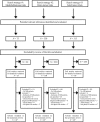Medulloblastoma in children and adolescents: a systematic review of contemporary phase I and II clinical trials and biology update
- PMID: 28980418
- PMCID: PMC5673921
- DOI: 10.1002/cam4.1171
Medulloblastoma in children and adolescents: a systematic review of contemporary phase I and II clinical trials and biology update
Abstract
Survival rates for patients with medulloblastoma have improved in the last decades but for those who relapse outcome is dismal and new approaches are needed. Emerging drugs have been tested in the last two decades within the context of phase I/II trials. In parallel, advances in genetic profiling have permitted to identify key molecular alterations for which new strategies are being developed. We performed a systematic review focused on the design and outcome of early-phase trials evaluating new agents in patients with relapsed medulloblastoma. PubMed, clinicaltrials.gov, and references from selected studies were screened to identify phase I/II studies with reported results between 2000 and 2015 including patients with medulloblastoma aged <18 years. A total of 718 studies were reviewed and 78 satisfied eligibility criteria. Of those, 69% were phase I; 31% phase II. Half evaluated conventional chemotherapeutics and 35% targeted agents. Overall, 662 patients with medulloblastoma/primitive neuroectodermal tumors were included. The study designs and the response assessments were heterogeneous, limiting the comparisons among trials and the correct identification of active drugs. Median (range) objective response rate (ORR) for patients with medulloblastoma in phase I/II studies was 0% (0-100) and 6.5% (0-50), respectively. Temozolomide containing regimens had a median ORR of 16.5% (0-100). Smoothened inhibitors trials had a median ORR of 8% (3-8). Novel drugs have shown limited activity against relapsed medulloblastoma. Temozolomide might serve as backbone for new combinations. Novel and more homogenous trial designs might facilitate the development of new drugs.
Keywords: Children; clinical trial; medulloblastoma; phase 1; phase 2; relapse or refractory tumor.
© 2017 The Authors. Cancer Medicine published by John Wiley & Sons Ltd.
Figures

Similar articles
-
A rapid and systematic review of the clinical effectiveness and cost-effectiveness of paclitaxel, docetaxel, gemcitabine and vinorelbine in non-small-cell lung cancer.Health Technol Assess. 2001;5(32):1-195. doi: 10.3310/hta5320. Health Technol Assess. 2001. PMID: 12065068
-
The effectiveness and cost-effectiveness of carmustine implants and temozolomide for the treatment of newly diagnosed high-grade glioma: a systematic review and economic evaluation.Health Technol Assess. 2007 Nov;11(45):iii-iv, ix-221. doi: 10.3310/hta11450. Health Technol Assess. 2007. PMID: 17999840
-
Comparison of first-line chemotherapy including escalated BEACOPP versus chemotherapy including ABVD for people with early unfavourable or advanced stage Hodgkin lymphoma.Cochrane Database Syst Rev. 2017 May 25;5(5):CD007941. doi: 10.1002/14651858.CD007941.pub3. Cochrane Database Syst Rev. 2017. PMID: 28541603 Free PMC article.
-
Platinum-containing regimens for metastatic breast cancer.Cochrane Database Syst Rev. 2017 Jun 23;6(6):CD003374. doi: 10.1002/14651858.CD003374.pub4. Cochrane Database Syst Rev. 2017. PMID: 28643430 Free PMC article.
-
A rapid and systematic review of the clinical effectiveness and cost-effectiveness of topotecan for ovarian cancer.Health Technol Assess. 2001;5(28):1-110. doi: 10.3310/hta5280. Health Technol Assess. 2001. PMID: 11701100
Cited by
-
Old drugs still work! Oral etoposide in a relapsed medulloblastoma.Childs Nerv Syst. 2019 May;35(5):865-869. doi: 10.1007/s00381-019-04072-9. Epub 2019 Feb 1. Childs Nerv Syst. 2019. PMID: 30707305
-
Etoposide-Bound Magnetic Nanoparticles Designed for Remote Targeting of Cancer Cells Disseminated Within Cerebrospinal Fluid Pathways.Front Neurol. 2020 Nov 27;11:596632. doi: 10.3389/fneur.2020.596632. eCollection 2020. Front Neurol. 2020. PMID: 33329349 Free PMC article.
-
Mixed signals from the cell's antennae: primary cilia in cancer.EMBO Rep. 2018 Nov;19(11):e46589. doi: 10.15252/embr.201846589. Epub 2018 Oct 22. EMBO Rep. 2018. PMID: 30348893 Free PMC article. Review.
-
Improved Long-Term Survival of Patients with Recurrent Medulloblastoma Treated with a "MEMMAT-like" Metronomic Antiangiogenic Approach.Cancers (Basel). 2022 Oct 19;14(20):5128. doi: 10.3390/cancers14205128. Cancers (Basel). 2022. PMID: 36291912 Free PMC article.
-
Identification of tumor rejection antigens and the immunologic landscape of medulloblastoma.Genome Med. 2024 Aug 19;16(1):102. doi: 10.1186/s13073-024-01363-y. Genome Med. 2024. PMID: 39160595 Free PMC article.
References
-
- Gilbertson, R. J. 2004. Medulloblastoma: signalling a change in treatment. Lancet Oncol. 5:209–218. - PubMed
-
- Farwell, J. R. , Dohrmann G. J., and Flannery J. T.. 1984. Medulloblastoma in childhood: an epidemiological study. J. Neurosurg. 61:657–664. - PubMed
-
- Packer, R. J. , Sutton L. N., Goldwein J. W., Perilongo G., Bunin G., Ryan J., et al. 1991. Improved survival with the use of adjuvant chemotherapy in the treatment of medulloblastoma. J. Neurosurg. 74:433–440. - PubMed
Publication types
MeSH terms
Substances
LinkOut - more resources
Full Text Sources
Other Literature Sources

